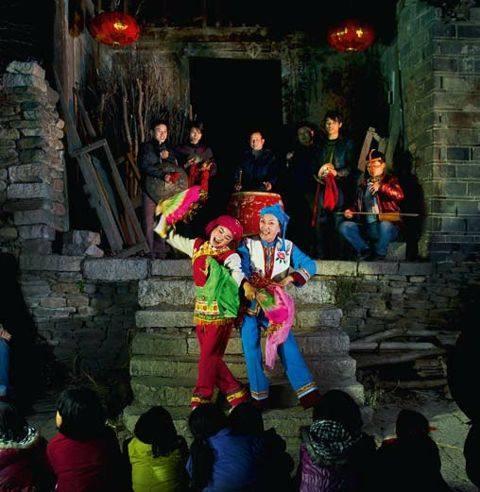Sublime Culture of the Tujia
by Chen Cigui and Liu Fang Hong Shi Peng Liping and Wu Xiaobing

Western Hunan Provinces Zhangjiajie City remains a hub of the Tujia people, allowing visitors to make close contact with strong Tujia ethnic culture both in Chieftain City in its urban district and Guanshuiping Village in the suburbs.
Folk Art in Chieftain City
A man-made cultural attraction sated with Tujia culture, Chieftain City was born as a park built on the site of one of the bestpreserved Tujia villages in western Hunan Province. Like many other ethnic cultural theme parks, employees wear traditional Tujia costumes, but they still dont adequately portray authentic Tujia people. For such employees, performing Tujia folk art to entertain tourists is just a job rather than a lifestyle. Still, some genuine folk artists remain, who manage to move visitors with their persistent adherence to tradition.
Early one morning as we roamed around Chieftain City, a souvenir shop adorned with a row of Xilankapu, handmade Tujia brocade, caught our eyes. Its proprietor, Zhou Liqun, is a Tujia brocader. “Xilankapu is a unique craft of the Tujia people,” she sighed, “but today only 20-something expert weavers of the brocade still operate in western Hunan.”In years past, Tujia girls began to learn brocading as teenagers. However, due to the expertise required to navigate the complexity of the craft, fewer and fewer girls are willing to sacrifice the hours it takes to learn. They may at least manage to embroider a pair of shoes for their wedding, a tradition meant to ensure a happy marriage.
Although Zhou has been fond of brocading since her youth, after graduating from college, she became an accountant. Still, her affection for Xilankapu only grew with each passing day. Eventually, she quither job and devoted her life to brocading.

Resting atop the loom in her shop was a pile of finished Xilankapu brocade, which took her several months of painstaking effort. According to her, embroidering a single pattern might take days, months, and even years because embroiderers must devote attention to each and every thread.
At Baishoutang (a venue used by the Tujia people to offer sacrifices to ancestors and perform traditional dance) in Chieftain City, we were lucky to enjoy breathtaking“sword-mountain climbing,” a traditional ritual reserved for sacrificial occasions. The performer playing Tima (literally“wizard” or “shaman”) blew an ox horn before climbing barefoot up a tall ladder with swords for rungs. He nimbly scrambled a dozen meters up in just a few seconds. During the process, he also performed a variety of stunts. Sometimes he stood on a single foot while freeing both hands, and other times he shifted his entire weight onto his abdomen resting on the edge of a sword. His thrilling performance evoked shrieks and gasps from spectators. “An expert fears nothing,” he grinned. “Ive practiced sword-mountain climbing for a dozen years. In fact, nothing is dangerous and mysterious.”
Ballads under Ancient Stilted Towers
Compared to the heavy tourist flow in Chieftain City, Tujia villages are more ideal to experience orthodox Tujia culture. Guanshuiping in Wangjiaping Town is a particular standout.
As our bus rolled towards the village, vast, green stretches of paddy fields dotted with stilted houses flashed outside the windows. To maintain the traditional dwelling lifestyle of the Tujia ethnic group, locals dont build mortar resi- dences, but refurbish decades-old stilted wooden houses through financial support from the government.
At the entrance to Guanshuiping, we arrived at an old roofed bridge spanning a stream. On one end of the bridge, several hospitable villagers, led by an elderly woman, sang to greet us. Their singing wasnt loud, but melodic. Tujia songs are notable for their lack of set lyrics. Instead, they are all improvised.
The 70-year-old woman is surnamed Gong. She established the Canola Blossom Art Troupe, which is comprised of all local women. Members are all consumed by farming in the daytime, so they can only find time to rehearse and perform at night or on rainy days.
When night fell, a large crowd of people gathered in front of the villages ancestral temple. Local women in theatrical costume began performing tea-gathering dances, each with a basket in arm. The nights entertainment reached a climax with a performance of folk Nuo Opera, unique to the Tujia ethnic group, which was inspired by stories of the god of land. The opera also lacked a fixed script and lines, and actors and actresses all improvised. The humorous performance caused laughter to fill the air above the villages century-old stilted houses.

